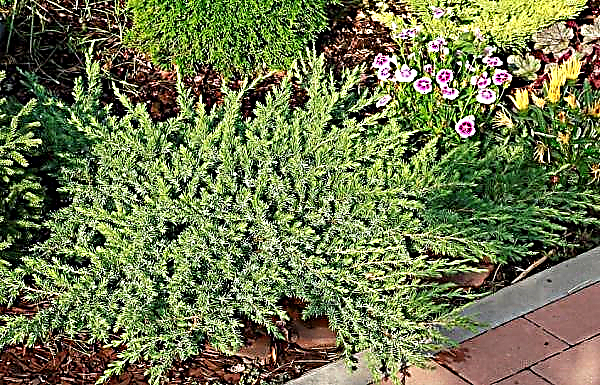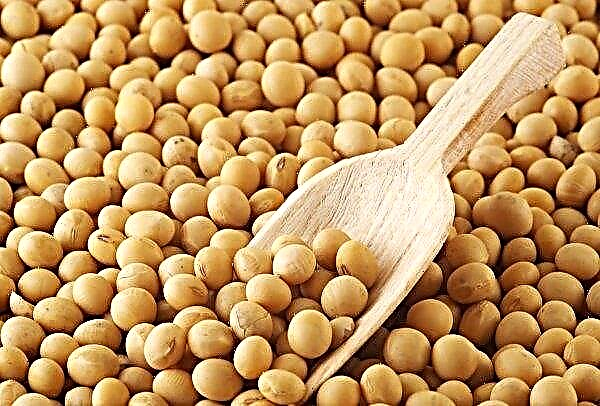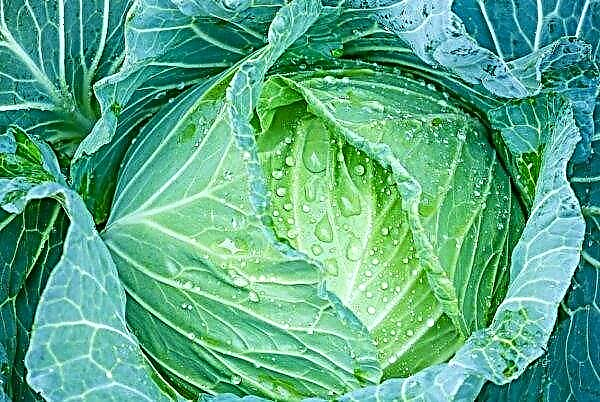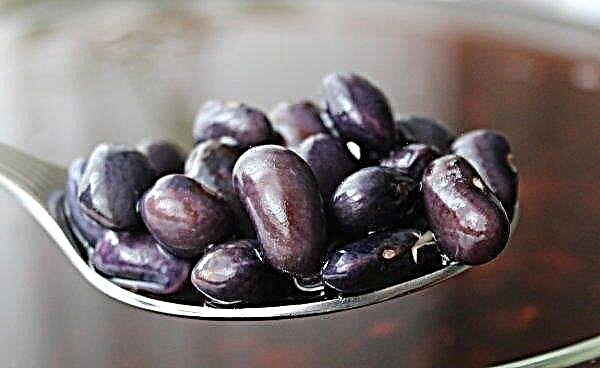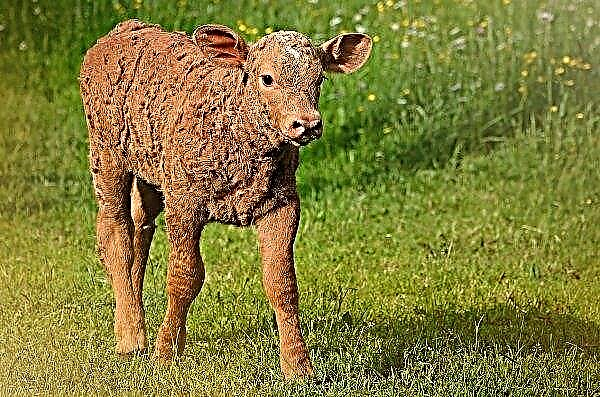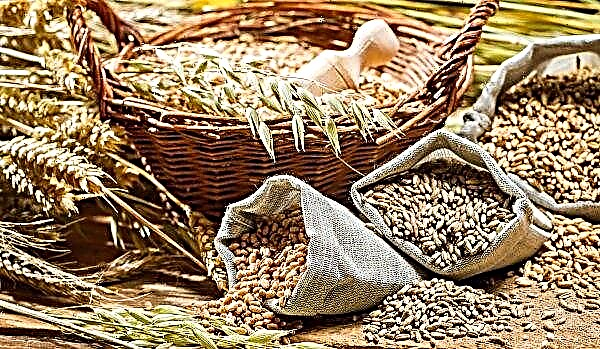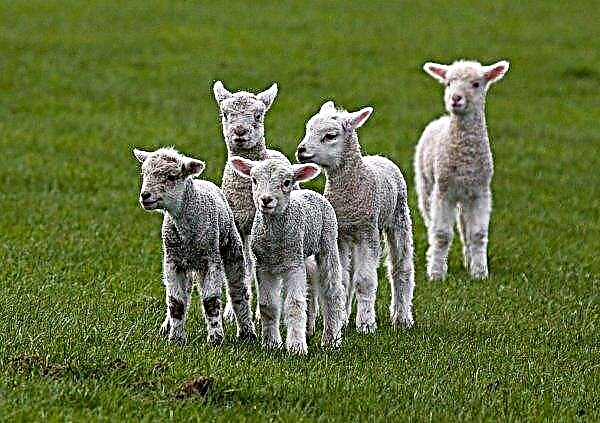For farmers whose main source of income is slaughter of chickens for meat, it is extremely important to quickly grow a healthy livestock whose meat will have good taste characteristics. The key to this is proper feeding. Traditional feed is less and less used for feeding chickens, giving way to compound feeds. Compound feed is a mixture of nutrients formed in the form of a granular powder.
Features of broiler feed
Feeding with compound feeds is gaining more and more popularity recently. Due to the fact that they contain almost everything a chicken needs, such feeds can easily replace other food for a bird. The feed is presented in the form of a granular mix of various cultures, vitamins and proteins.
Did you know? The first sample of compound feed was produced in 1813, but it did not receive development, as it was perceived as a by-product.
Pros
- Combined feed feeding has several advantages:
- combined feeds allow birds to gain weight for slaughter as quickly as possible;
- compound feed contains a full range of vitamins and amino acids needed by chicken.
Minuses
- The minuses of feed include:
- high cost;
- the need for a large amount of water and control over its consumption by birds;
- significant presence in the market of low-quality manufacturers.
Types of feed for different periods of growing up and their composition
There are three power schemes:
- two-phase, including start and finish;
- three-phase, including start, growth and finish;
- four-phase, including pre-start, start, growth and finish.
"Start"
This stage also includes pre-launch in three-phase feeding. The starting stage starts from the moment the chicken hatches and lasts up to 30 calendar days with two-phase feeding and up to 15-18 calendar days with other schemes.  Quality starter has the following composition:
Quality starter has the following composition:
- 36% - cereals;
- 30% - soybean meal;
- 21% - millet;
- 5.5% - oil and rapeseed cake;
- 5% - proteins, chalk, salt, soda, phosphates;
- 2.5% - corn gluten and molasses.
"Height"
This species is evenly distributed between the start and finish during two-phase feeding and from the 15–18th calendar day to the 37th with other feeding schemes and is oriented towards the formed chickens.  It includes such components:
It includes such components:
- yeast;
- phosphates;
- fish and meat meal;
- soy and sunflower makukha;
- enzymes and amino acids;
- calcium carbonate.
The percentage of feed components may vary depending on the manufacturer. At this stage, the birds have already formed, and therefore there is a clean weight gain, daily up to 50 kg. Food is taken 3-4 times a day in a volume of 90 to 150 g, depending on the breed.
"The finish"
“Finish” food is given to chickens starting from the 30th day with two-phase nutrition and from 15-18 days with other nutritional schemes and continues until the chicken is slaughtered. It includes:
- 45% - wheat;
- 24% - cereals;
- 16% - meal from soy;
- 6% - fish meal;
- 5% - sunflower meal;
- 3% - sunflower oil;
- 1% - limestone flour, salt, minerals and vitamins.
 The main purpose of this feed is to gain weight for slaughter. It is taken twice a day and gives a daily gain of 50 g.
The main purpose of this feed is to gain weight for slaughter. It is taken twice a day and gives a daily gain of 50 g.
Standards and quality requirements
There are several standards that quality feed must meet:
- the presence in the feed of proteins, proteins, feed wheat, cereal, mineral components and vitamins;
- lack of antibiotics;
- fine grinding.
The best manufacturers of feed
To choose a good feed, you need to know the producers whose products are of high quality and are in demand among consumers.
"Rose"
Produced in the Donetsk region, Rozovsky compound feed occupies a firm position in the market due to the strengthening of livestock immunity, high quality ingredients and affordable price.
"Provimi"
Provimi compound feeds are becoming increasingly popular due to their high quality and innovation - the company invests a lot in conducting a wide range of studies aimed at improving the quality of feed.
Did you know? The three largest feed producing countries in the world are the People's Republic of China (183 million tons / year), the USA (177 million tons / year) and Brazil (66 million tons / year).
"Generous Niva"
The products of "Generous Niva" have established themselves due to the presence of not only all the necessary elements in the feed composition, but also vitamin supplements. In addition, feed companies demonstrate the highest conversion of food to weight compared to competitors. The products are full-sized, and therefore suitable at all stages of the life of the chicken.
"Purina"
Purina is one of the oldest companies on the market; its activity began back in the 19th century. Since then, the company has been developing and today all the accumulated experience has been reflected in the feed produced by Purina. Its strengths are a balanced composition containing all the elements necessary for chicken growth, the absence of antibiotics in them and the presence of digestive enzymes. The presence of feed for all stages of feeding allows you to support birds at different ages. There are no special requirements for eating. Separately, it is worth noting PK-6 compound feed. This food is the most popular for the finishing phase of feeding. This is due to the fact that it was specially developed to complete the feeding - almost two thirds of the composition falls on wheat and cereal crops (46% and 23%, respectively), and the premix contains all the necessary vitamins.
Separately, it is worth noting PK-6 compound feed. This food is the most popular for the finishing phase of feeding. This is due to the fact that it was specially developed to complete the feeding - almost two thirds of the composition falls on wheat and cereal crops (46% and 23%, respectively), and the premix contains all the necessary vitamins.
How to make DIY feed for broilers
If the purchased combination feed is too expensive or none of the feeds on the market suits the chickens, it is possible to prepare the feed yourself. The proposed recipe is designed to produce one kilogram of feed.
Composition and proportions
The table contains data on the ingredients necessary for the manufacture of animal feed:
| corn | 260 g |
| wheat | 150 g |
| barley | 100 g |
| sunflower meal | 120 g |
| fish meal | 100 g |
| meat and bone meal | 80 g |
| feed chalk | 10 g |
| feed fat | 20 g |
| grass meal | 40 g |
| feed yeast | 30 g |
| shell | 40 g |
| premix | 20 g |
| vegetable oil | 30 g |
Important! As fodder fat, melted lard or chicken fat can be used.
Step-by-step cooking instructions
Preparation of feed includes the following steps:
- Use the scales to measure the required amount of each ingredient.
- Pour ingredients into a bucket or other suitable container.
- Mix the ingredients thoroughly, pass through a granulator (if any).
- Let the mixture stand for 10 minutes.
Video: Cooking Broiler Feed
How to feed broilers
To properly feed broilers, you need to know a few basic rules and how much food birds should eat.
Basic feeding rules
The basic rules of feeding include:
- Combined feeds are used with minerals and vitamins - the exception is when antibiotics are injected into chickens.
- The amount of feeding and food intake are selected based on the age of the bird.
- The number of meals is reduced in the process of growing birds.
Daily rate and diet
As already mentioned, the nutrition of birds is calculated based on their age. On average, the first two weeks of life, the chicks eat 6 times a day, eating an average of 10–20 g per meal (the amount of food increases with the growth of chicks). The next 10-15 days, food is taken 3 times a day, 40 g of food at a time. At the final stage, the feed is taken twice a day in a volume of 80 g.
Feed consumption before slaughter
Many broiler owners are interested in the question of how much feed one bird eats during growth. On average, up to 4 kilograms of feed per bird.
Compound feed today is an integral element of the broiler diet. It allows you to quickly raise birds for slaughter and provides a high percentage of meat obtained from chickens. The versatility of feed makes it the most optimal choice for every farmer.Important! Chickens and roosters have different weight gains with the same feeding.

